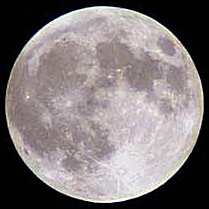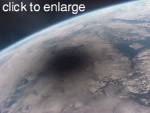 The Moon is the Earth's sole companion, orbiting at an average distance of 384,400km. It follows us on our path around the Sun, making one orbit of us (as seen against the background of stars) every 27 days, 7 hours, 43 minutes. This period is referred to as the sidereal month. The Moon's equatorial diameter measures 3,476km making it less than one third the diameter of the Earth. The Moon is the Earth's sole companion, orbiting at an average distance of 384,400km. It follows us on our path around the Sun, making one orbit of us (as seen against the background of stars) every 27 days, 7 hours, 43 minutes. This period is referred to as the sidereal month. The Moon's equatorial diameter measures 3,476km making it less than one third the diameter of the Earth.
 Eclipses Eclipses
As the orbital plane of the Moon lies within 5° of the apparent orbit of the Sun as seen from Earth, occasionally their positions in the sky coincide, giving rise to a solar eclipse. The photo above shows the shadow cast by the moon - around 100 km across it moves at over mach 2!
Solar Eclipses
At other times the Moon's orbit takes it into the shadow cast by the Earth into space, causing a lunar eclipse. Unlike solar eclipses, Lunar eclipses are readily observed from large areas of the Earth's surface, due to the greater extent of the Earth's shadow than that of the Moon's.
Lunar Eclipses
 Map of the Moon Map of the Moon
Philip's do a large map of the Earth-facing side of the Moon with over 500 named features plus the landing sites of spacecraft. It's perfect for any classroom wall, or even for serious observations. More info: UK | USA.
Top Right ^^
|
Buying Land on the Moon
Some companies are pretending to sell land on the moon to unsuspecting individuals, and claim the sales are legal. This is clearly complete rubbish. "It is a disgusting rip-off. These wonderful planets are there for everyone to admire for free," said Patrick Moore.
|
 Changing Phases Changing Phases
As we see the Moon only in reflected light, it shows distinct phases, depending on the angle made between itself, the Sun and the Earth. At New Moon, all three bodies are aligned, with the Moon between the Earth and the Sun. During this phase, despite the absence of direct illumination by the Sun, the lunar surface is just visible in light reflected from the Earth. Full Moon occurs when the Earth lies directly between the Sun and the Moon, with first and last quarters occurring at the 90° and 270° positions. The time taken from New Moon to New Moon, called the synodic month, is 29 days, 12 hours, 44 minutes.
 Of course, the Earth also goes through phases as viewed from the Moon! The photograph on the right is of the Earth taken by Apollo astronauts. Note that the earth is very bright compared to the moon. Check out the amazing twin cresents here. Of course, the Earth also goes through phases as viewed from the Moon! The photograph on the right is of the Earth taken by Apollo astronauts. Note that the earth is very bright compared to the moon. Check out the amazing twin cresents here.
Lunar Rover Schematics
The Moon was first visited by spacecraft from Earth in the 1960s. On July 20, 1969, the first men stepped foot on the Moon, from Apollo 11. After 1972, no further exploration was made for over 25 years. In 1997, the Lunar Prospector was launched to orbit the Moon, at an altitude of 63 miles, to carry out a one-year mapping mission; paving the way for future construction of manned bases.
Moon Software
To download moon-related software, or follow links to other websites, click here.
Navigate:
The Moon Tonight!

View/Sign Guestbook
|


